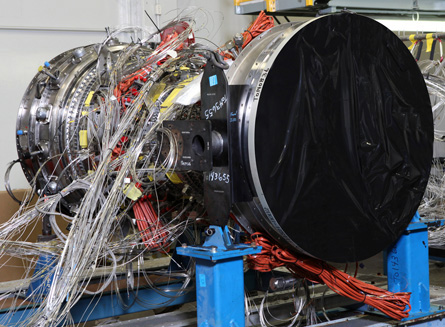General Electric (GE) is set to undertake the first core test of its version of the US Air Force Research Laboratories' (AFRL) adaptive versatile engine technology (ADVENT) engine technology demonstrator.
The company hopes to start the first core test later this month in Cincinnati, Ohio. GE says it anticipates running a full engine test in early 2013. It has already demonstrated the key adaptive fan technology necessary to build a variable cycle engine at Wright Patterson AFB, Ohio.
 |
|---|
©General Electric |
Rival Rolls-Royce has also completed testing for the fan section of its ADVENT demonstrator, company officials said in June. Rolls-Royce says it hopes to test its core before the end of the year.
The wild card is Pratt & Whitney (P&W). Though the company has not awarded an ADVENT contract by the USAF, P&W is pressing ahead with its own privately funded variable cycle engine demonstrator. The company told reporters that it hopes to test a version of its F135 engine modified with an adaptive fan and new high pressure core in the first quarter of 2013, at the Farnborough airshow in July.
P&W hopes to displace one of the ADVENT programme incumbents, either Rolls-Royce or GE, for the AFRL's follow-on adaptive engine technology development (AETD) effort. The goal of the new programme is to develop the engine technology needed for a potential sixth-generation follow-on to the USAF's Lockheed Martin F-22 Raptor.
But the technology is equally applicable to programmes such as the US Navy's nascent F/A-XX sixth-generation fighter. The USN is currently engaged in a study called variable cycle advanced technology (VCAT), but the service is not as far along in its efforts as the USAF. The USN needs a new fighter to replace the Boeing F/A-18E/F in the mid-2030s. USN officials have said that they want greater range and kinematic performance out of their future next generation fighter.
The USAF expects that variable cycle engines will yield at least a 25% fuel burn advantage, which should lead to greater ranges. But an adaptive fan also produces a third airflow steam that can be used for greater power extraction or thermal management. It should also lead to a reduction in installed drag, improved inlet recovery, lower exhaust temperatures according to GE.
The company says its adaptive engine approach has "internal variable features that adjust bypass ratio and pressure ratio to optimize operation for a wide range of flight conditions".
Source: Flight International



















